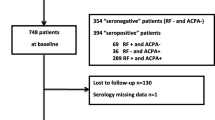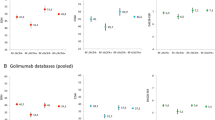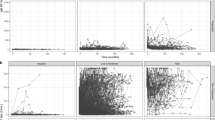Abstract
The objective of this study is to identify baseline factors associated with rheumatoid arthritis (RA) diagnosis at the end of 1-year follow-up in a cohort of patients with very recent onset arthritis. Incident cases with self-reported arthritis (≤12 weeks) referred by primary care physicians were assessed by a designated rheumatologist who predicted in those with ≥1 swollen joint the diagnosis of RA at the end of follow-up. Patients were regularly seen and diagnosed through follow-up by staff rheumatologists who were blind to diagnostic prediction. Of 119 referrals, 78 (65.5%; age 35.5 ± 13.5 years; 69 females) were diagnosed at baseline as very recent onset arthritis (median duration 6 weeks (0–12 weeks)); of 75 patients completing 1-year follow-up, 51 (66.5%) were classified as RA; 12 (16%) had self-limited arthritis; and 13 (17.5%) other diagnoses. The characteristics of patients with RA as final diagnosis were polyarthritis, morning stiffness ≥1 h, high counts of swollen joints, and low frequency of systemic symptoms. Rheumatologist prediction of RA and anti-cyclic citrullinated peptide (anti-CCP) antibodies was strongly associated with RA as a final diagnosis in the logistic regression analysis. Sensitivity and specificity of the rheumatologist prediction were 94% and 74%, for anti-CCP antibodies, 56% and 96%; the combination of both variables had a specificity of 100% and a sensitivity of 53%, and a positive predictive value of 98%. The combination of RA as predicted diagnosis by a rheumatologist and anti-CCP antibodies is highly specific for RA diagnosis in patients with very early arthritis.

Similar content being viewed by others
References
Gordon DA, Hastings DE (2003) Clinical features of rheumatoid arthritis. In: Hochberg MC, Silman AJ, Smolen JS, Weinblat ME, Weisman MH (eds) Rheumatology, 3rd edn. Mosby, Edinburgh, pp 765–780
Van der Heijde D, van Riel PL, Nuver-Zwart HH, Gribnau FW, van de Putte LBA (1989) Effects of hydroxychloroquine and sulphasalazine on progression of joint damage in rheumatoid arthritis. Lancet 1:1036–1038
Egsmose C, Lund B, Borg G, Pettersson H, Berg E, Brodin U et al (1995) Patients with rheumatoid arthritis benefit from early 2nd line therapy: 5-year followup of a prospective double blind placebo controlled study. J Rheumatol 22:2208–2213
Abu-Shakra M, Toker R, Flusser D, Flusser G, Friger M, Sukenik S et al (1998) Clinical and radiographic outcomes of rheumatoid arthritis patients not treated with disease modifying drugs. Arthritis Rheum 41:1190–1195
Krause D, Schleusser B, Herborn G, Rau R (2000) Response to methotrexate treatment is associated with reduced mortality in patients with severe rheumatoid arthritis. Arthritis Rheum 43:14–21
Choi HK, Hernán MA, Seeger JD, Robins JM, Wolfe F (2002) Methrotexate and mortality in patients with rheumatoid arthritis: a prospective study. Lancet 359:1173–1177
Harrison BJ, Symmons DPM, Barret EM, Silman AJ (1998) The performance of the 1987 ARA classification criteria for rheumatoid arthritis in a population based cohort of patients with early inflammatory polyarthritis. J Rheumatol 25:2324–2330
Van der Helm-van Mil AHM, Saskia LC, von Dongen H, Breedveld FC, Toes REM, Huizinga TWJ (2007) A prediction rule for disease outcome in patients with recent-onset undifferentiated arthritis. Arthritis Rheum 56:433–440
Visser H, le Cessie S, Vos K, Breedveld FC, Hazes JMW (2002) How to diagnose rheumatoid arthritis early. A prediction model for persistent (erosive) arthritis. Arthritis Rheum 46:357–365
Machold KP, Stamm TA, Eberl GJM, Nell VKP, Dunky A, Uffman M (2002) Very recent onset arthritis-clinical, laboratory, and radiological findings during the first year of disease. J Rheumatol 29:2278–2287
Arnett FC, Edworthy SM, Bloch DA, McShane DJ, Fries JF, Cooper NS et al (1988) The American Rheumatism Association 1987 revised criteria for the classification of rheumatoid arthritis. Arthritis Rheum 31:315–324
Harrison BJ, Symmons DPM, Brennan P, Barret EM, Silman AJ (1996) Natural remission in inflammatory polyarthritis: issues of definition and prediction. Br J Rheumatol 35:1096–1100
Tan EM, Cohen AS, Fries JR et al (1982) The 1982 revised criteria for the classification of systemic lupus erythematosus. Arthritis Rheum 25:1271–1277
O’Dell JR (2004) Therapeutic strategies for rheumatoid arthritis. N Engl J Med 350:2591–2602
Schellekens GA, Visser H, de Jong BAW, van den Hoogen FHJ, Hazes JMW, Breedveld FC et al (2000) The diagnostic properties of rheumatoid arthritis antibodies recognizing a cyclic citrullinated peptide. Arthritis Rheum 43:155–163
Nielen MMJ, Van Schaardenburg D, Reesink HW, Van de Stadt RJ, Van der Horst-Bruinsma IE, De Koning MHMT et al (2004) Specific autoantibodies precede the symptoms of rheumatoid arthritis. A study of serial measurements in blood donors. Arthritis Rheum 50:380–386
Rantapää-Dahlqvist S, De Jong BAW, Berglin E, Hallmans G, Wadell G, Stenlund H et al (2003) Antibodies against cyclic citrullinated peptide and IgA rheumatoid factor predict the development of rheumatoid arthritis. Arthritis Rheum 48:2741–2749
Disclosures
None.
Author information
Authors and Affiliations
Corresponding author
Rights and permissions
About this article
Cite this article
Rojas-Serrano, J., Burgos-Vargas, R., Lino Pérez, L. et al. Very recent onset arthritis: the value of initial rheumatologist evaluation and anti-cyclic citrullinated peptide antibodies in the diagnosis of rheumatoid arthritis. Clin Rheumatol 28, 1135–1139 (2009). https://doi.org/10.1007/s10067-009-1206-z
Received:
Revised:
Accepted:
Published:
Issue Date:
DOI: https://doi.org/10.1007/s10067-009-1206-z




